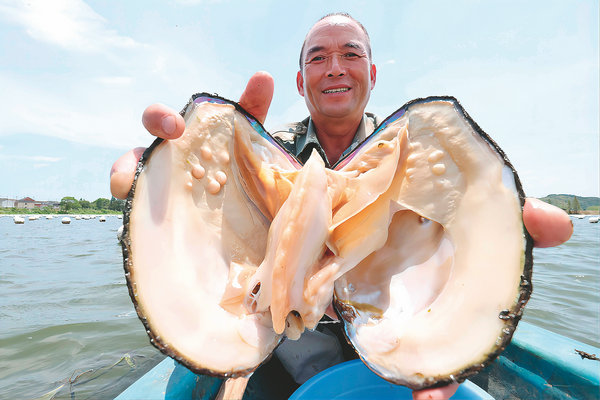Agriculture aims to expand crop of interest in crucial sector

Deqing county, Zhejiang province, is one of the country's largest freshwater pearl production bases. [Photo provided to China Daily]
Rows of white floating spheres dot the water. A farmer paddles a boat, meticulously inspecting pearl oysters. This is Deqing county, Huzhou city, East China's Zhejiang province, renowned as one of China's largest freshwater pearl production bases.
During the Southern Song Dynasty (1127-1279), Ye Jinyang from Huzhou developed the freshwater pearl farming technique and then popularized it throughout the region.
In 2017, Deqing's freshwater pearl farming was added to China's list of vital agricultural heritage due to its unique ways of using traditional practices and knowledge while maintaining the ecosystem. Pearls can be transformed into various products, including jewelry and cosmetics.
A national conference on agricultural heritage systems was held in the county last month with the theme "exploring the value of agricultural heritage, creating a blueprint for urban and rural development".
More than 140 experts, postgraduate students from 35 research institutes and universities across China, and technical personnel from key agricultural heritage sites in the country participated in the conference.
Over 30 domestic experts presented their academic research in four sub-forums, covering topics such as investigating agricultural heritage systems and safeguarding farming culture.
"Interdisciplinary collaboration is a key feature of the conference," says Min Qingwen, director of the Agricultural Heritage System-Branch of the China Association of Agricultural Science Societies, which co-organized the conference. "Our goal is to discuss issues with experts from relevant fields."
The conference also invited two international experts — Akira Nagata, a visiting research fellow at the United Nations University Institute for the Advanced Study of Sustainability, and Park Yoon-ho, vice-chairman of the Korea Rural Heritage Association. They introduced the sustainable conservation and utilization of Japan and South Korea's agricultural heritage systems, respectively.
Park says that in South Korea, the main challenges for conserving the systems are depopulation and the aging population, especially in rural areas, and less value attached to the agriculture sector in the national economy.
"While government support is crucial for conserving agricultural heritage systems, the primary focus should be on empowering the local communities to manage these resources independently," he says.
In 2002, the Food and Agriculture Organization of the United Nations launched its Globally Important Agricultural Heritage Systems list.
With 22 sites inscribed on the list, China stands out as the leading contributor to the prestigious roster. Deqing county's freshwater pearl farming is also applying for it.
The inscription can boost the cultural confidence of locals and encourage the younger generation to learn about the pearl culture, says Jiao Wenjun, associate researcher of the Institute of Geographic Sciences and Natural Resources Research, Chinese Academy of Sciences.
Deqing's pearl-themed study tours are drawing students in recent years. They can learn about pearl farming techniques and make pearl bracelets in workshops.
Min believes that agricultural heritage systems in China have many advantages.
China's vast territory includes diverse ecological and geographical types including grasslands, oceans and plateaus, resulting in varied agricultural practices.
"The central government attaches great importance to agricultural heritage systems and has introduced relevant policies to promote their development. Also, scientists from various fields are working closely to advance this course," he says.
He notes stricter requirements for the application and designation of Globally Important Agricultural Heritage Systems, such as detailed documentation and thorough inspections, pose challenges for heritage site managers and scientists.
"It requires interdisciplinary expertise in economic, ecological, technical, cultural and landscape aspects to address these challenges," he says.





 play
play